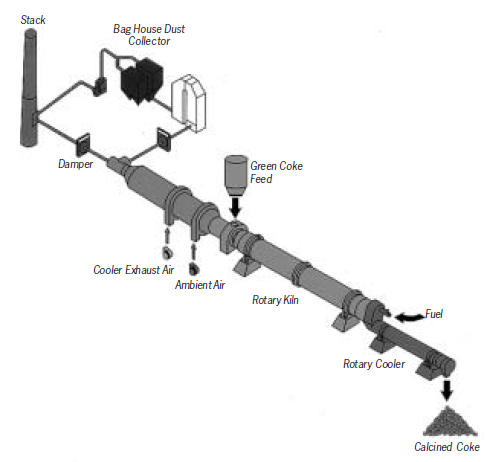In a mineral processing plant, with upgrading we understand, the further processing of the final products from the enrichment stages in a process.
This is valid both concerning the valuable minerals (the concentrate) and the waste minerals (the tailings).
In the first case upgrading means improving the product value by bringing the concentrate to transportability or into a completely dry form. Processing can also go further to calcining and sintering. On the tailing side upgrading means that waste material (wash water, process effluents etc.) is properly taken care of in order to protect the environment, to recover process water and to turn certain portions into valueables.
Upgrading by methods
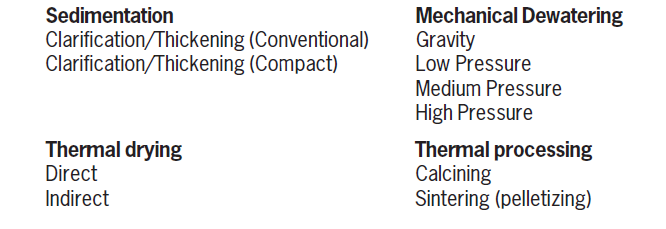
Upgrading by operation costs
Upgrading has its price, increasing with the energy input for removal of the process water (or process liquid).
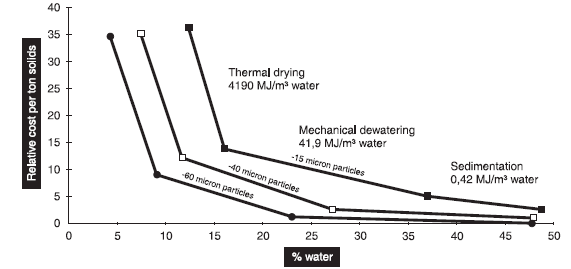
curves above must always be considered when we are selecting equipment for an upgrading circuit for concentrate drying or disposal of a washing effluent.
The rules are simple!
1. Can we do the job with sedimentation only? If not - how far can we reach by sedimentation thereby saving money in the following dewatering stage?
2. How far can we reach with mechanical dewatering? Can we save a thermal stage by increasing the dewatering pressure?
3. If the particles are coarse, can gravity dewatering do the job? The cost is close to the same as for sedimentation.
4. If thermal dewatering is needed, can energy be saved in drying by improved mechanical dewatering?
Sedimentation
Sedimentation is a continuous solid-liquid separation process with settling of solids by gravity. Clarification is the process for removal of solids from a dilute solid/liquid suspension. Thickening is the process for concentrating particles in a supension by gravity compression
Flocculation
All sedimentation technologies are related to particle size. One way of improving the settling speed generally is therefore to increase the size of the particles.
Fine particles can be connected together by coagulation or flocculation. The settling rate of the combined particles will be higher than that of each individual particle.
Flocculation System
A handling system is needed for flocculant utilisation. This comprises provision to mix, store and dilute the polymer. The dilute polymer is then mixed with the feed slurry and allowed to condition (or age) before a sedimentation or dewatering process.
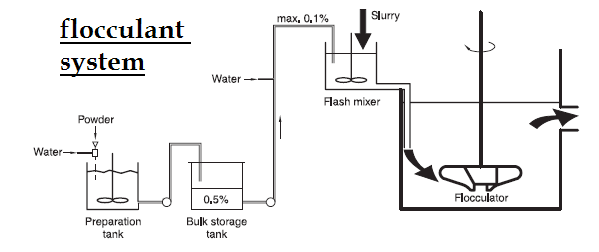
Flocculation - addition and mixing time

Conventional Clarifier
Clarification is achieved when the liquid “upstream” velocity VL is lower than the sedimentation velocity of the solids VS
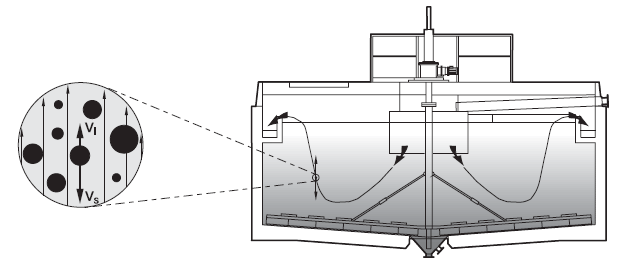
Conventional Clarifier – sizing
Clarifier diameter is selected to give a suitable upstream velocity (m/h). This is also expressed as “Surface Load”, meaning the volume of slurry m3/h fed per m2 of clarifier surface. Typical surface areas are given below.
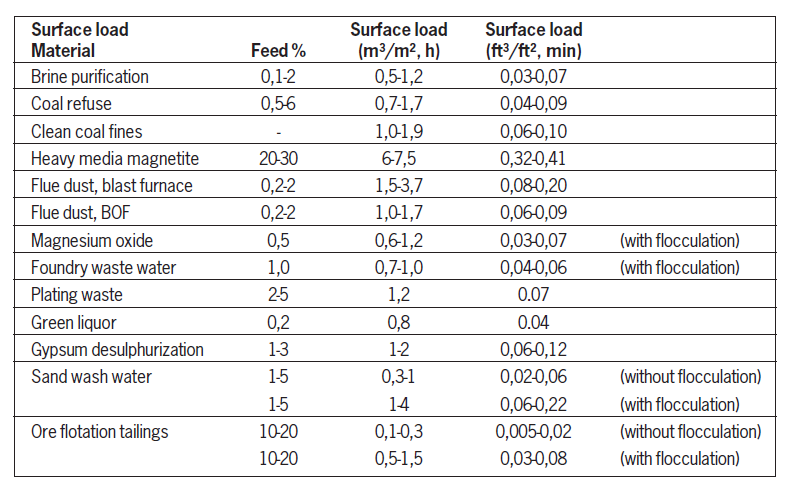
Conventional Thickener
Continuous thickening to give the required solids concentration in the underflow depends on balancing the volumetric solids flow rate at a critical concentration with the diameter of the thickener.
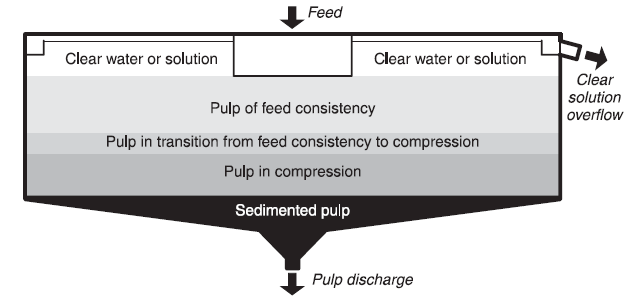
Conventional Thickeners – Sizing
Thickener selection is based upon the unit area, defined as m2 of thickener area required per tph of solids. Typical figures for unit area are given below.
Clarification/ thickening – cross checking (metric)
Clarification and thickening are process definitions. The equipment can be applied to both duties. If this is the case we have to select the tank area for each duty and select the largest of the two.
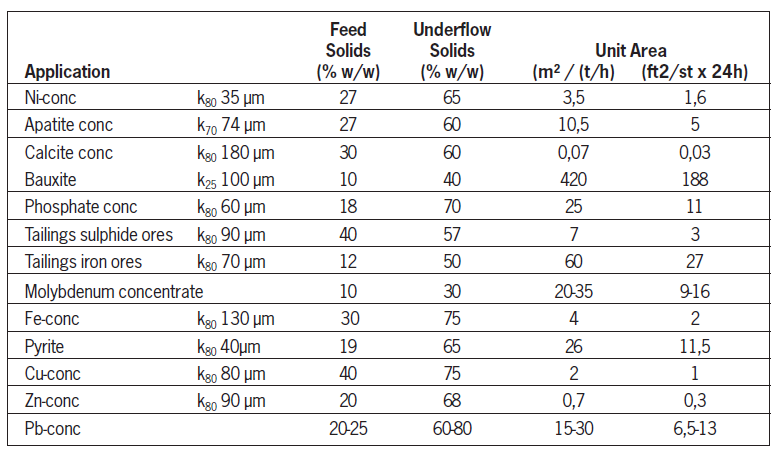
Conventional Clarifier/Thickener – Design
Bridge type
For smaller thickeners, up to 30 – 40 m diameter, the rakes and drive mechanism are supported on a bridge superstructure, which straddles the tank as shown.
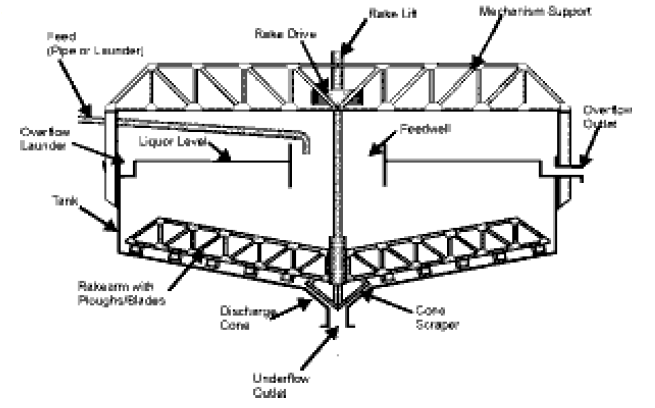
Centre Pier type
For tanks over 30 – 40 m diameter a bridge structure will be imractical. The mechanism and rakes are therefore supported from a centre pier and the bridge is only used for access and to support feed pipe and launder.
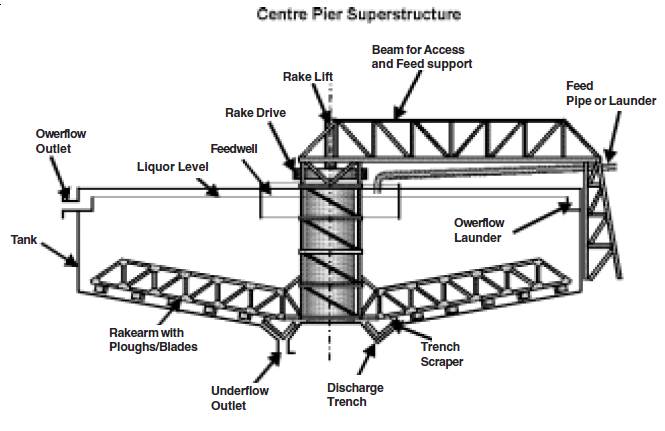
Design options
Up to 20 m elevated tank with underflow at ground level. Above 20 m tank at ground level with underflow in a tunnel.
Conventional clarifier/thickener – control
Torque is electronically detected and monitored. Increased torque is a sign that the solids loading in the thickener may be building up. This could indicate a process problem (change in feed, blocked underflow etc.). In all these cases rakes and drive have to be protected.
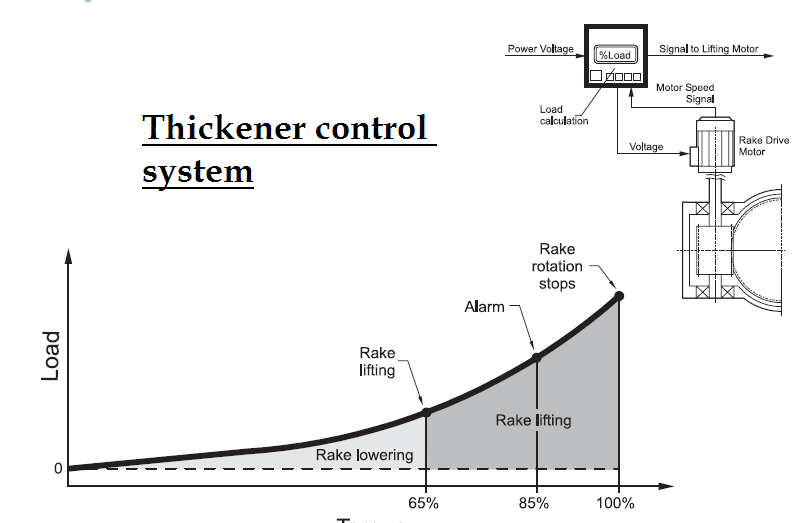
Conventional Clarifier/Thickener – Areas
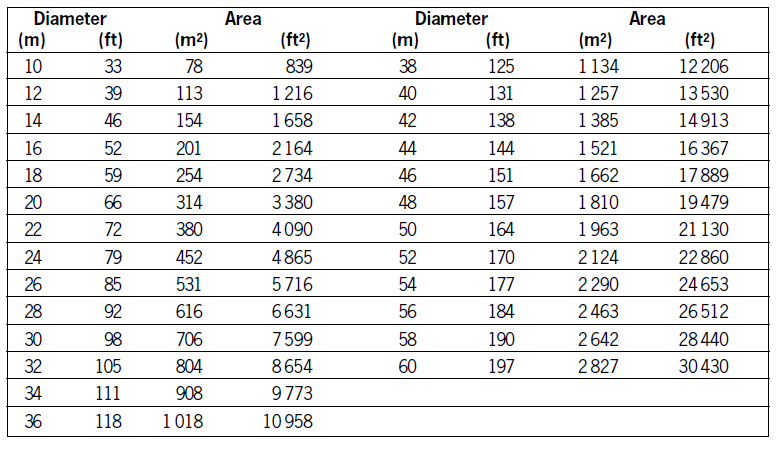
Conventional Clarifier/Thickener – Tank Depth
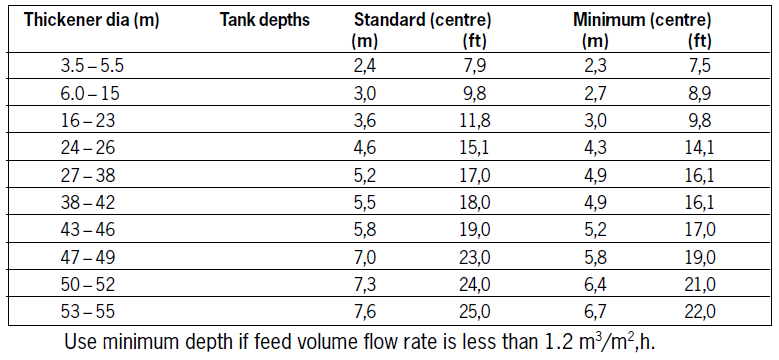
Conventional Clarifier/Thickener – Tank Bottom Slope
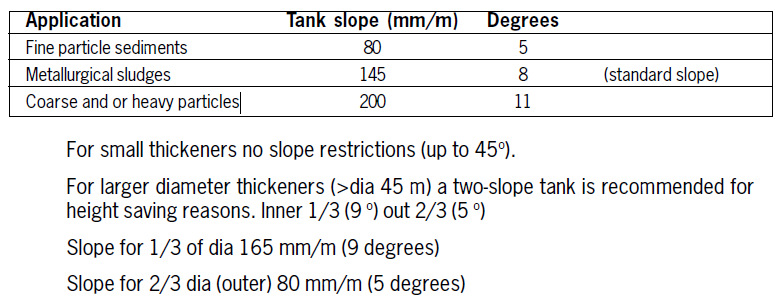
Lamella plates – principle
The Clarifiers and Thickeners are utilising the ‘Lamella or Inclined Plate Principle’ to perform sedimentation processes in much more compact equipment than would be possible using conventional techniques. Some typical comparisons of floor area requirements are given below
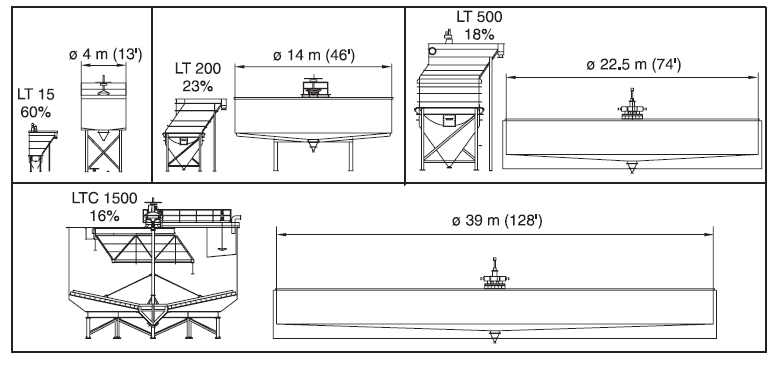
The Lamella concept offers many practical advantages:
• Reduced plant area requirements
• Reduced retention time
• Possibility to optimise the ratio of clarification & thickening area
• Low heat losses – easy to insulate
• Low water losses due to evaporation – easy to cover
• Transport of the unit is more practical
• More suitable for indoor installation
• Quicker installation
• Easier to manufacture special designs (rubber lined, stainless steel etc.)
• Lower capital costs
There are limitations to the ‘lamella concept’ and in these cases conventional
thickeners would be preferred. Examples are:
• High surface loads (above approx. 2.5m3/m2h (0.14 ft3/ft2min)
• Coarse or dense particles
• Feeds with a high solids content
• High froth content (Flotation concentrate)
• Requirements for particularly high underflow density or storage volume
Lamella plates – function
The area above the feed points is regarded as clarification area (Acl), this can be up to 80% of the total plate area. The area beneath the feed point is thickening area (Ath), this can be up to 50% of the total plate area.
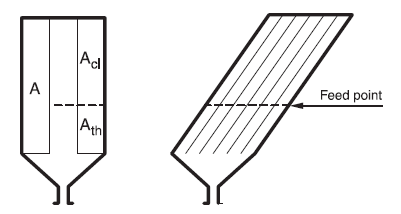
Mechanical Dewatering – Introduction
Mechanical dewatering means mechanical removal of liquids from a slurry to obtain the solids in a suitable form and/or recovery of a valueable liquid for:
• Further processing
• Transportation
• Agglomeration
• Disposal
• Recovery of valuable liquids
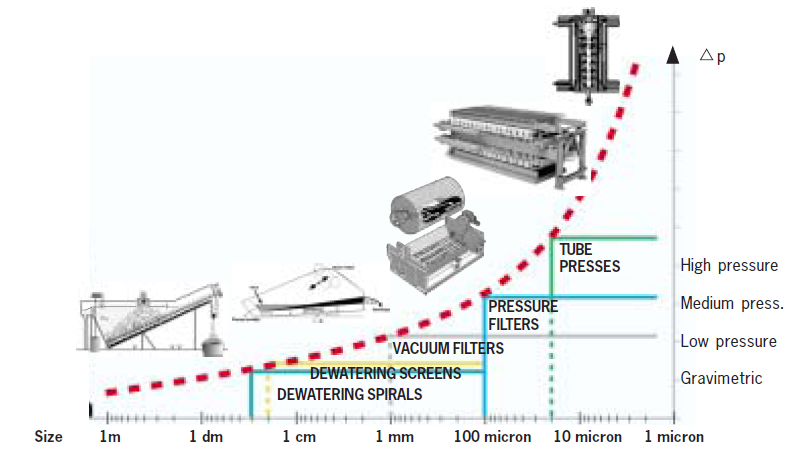
Mechanical Dewatering – Methods and Products
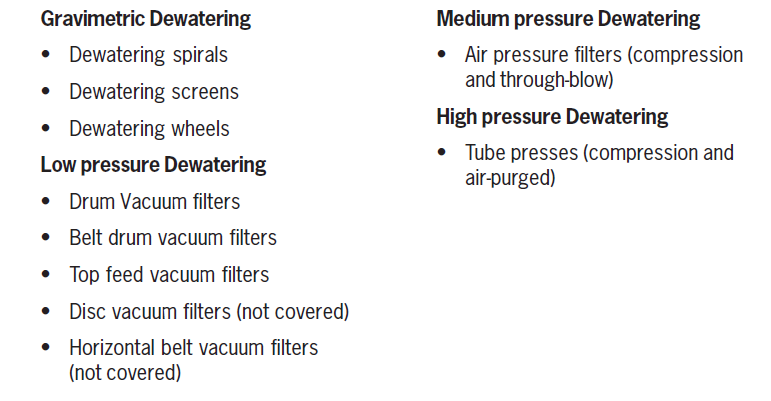
Gravimetric Dewatering.
When the particles in a slurry are too coarse for the capillary forces to “trap” the water, the use of gravity is enough to remove the water and give at least transportable solids.
Spiral Dewaterer
Spiral dewaterer for coarse solids (not deslimed).
• Feed 1% solids by w.
• 10 – 1 000 m3/h (44-44 000 USGPM)
• Remaining moisture approx. 30% h2O
• Large sedimentation-pool
• Oil scimmer as option
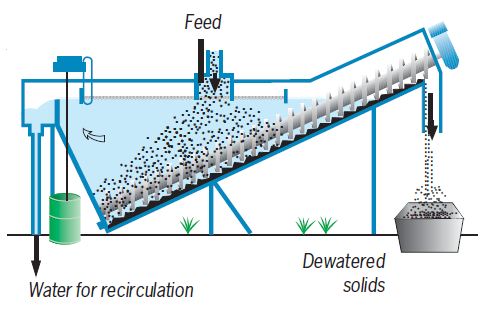
Sand Screw
This is a simpler version of the Spiral dewaterer mainly used for natural sand.These sands are normally classified (particles below 10-50 micron are removed) meaning that the sedimentation pool is very limited compared to the Spiral Dewaterer.
• Feed ratio sand : water app. 1:3
• Capacity 6-95 m3/h
• Remaining moisture content
20-25 % H2O by weight
• Screw inclination app. 25o
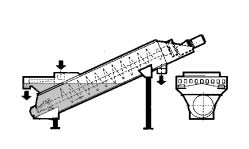
This is a version of a screen in linear motion moving the solids upwards on an inclined plane at an inclination of 5o. Dewatering takes place in the moving sand bed.
• Only for sand, coal or other deslimed solids
• Feed containing max. 50 % solids by weight
• Remaining moisture content 13-17 % H2O by weight
• Capacities 70-190 (sand), 5-55 (coal)
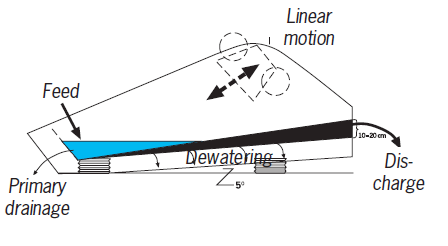
Dewatering Wheel
The dewatering wheel is mainly used in dredging of natural sand and gravel. The machine has a simple water draining arrangement at the sand removal buckets. Therefore the water content can be reduced down to 15-18 % H2O by weight even if the feed contains certain fines. The pool is limited meaning that the machine is sensitive to high volume flows.
• Feed size (typical) 0-2 mm
• Variable speed as option
• Feed flow 1 500-2 400 m3h
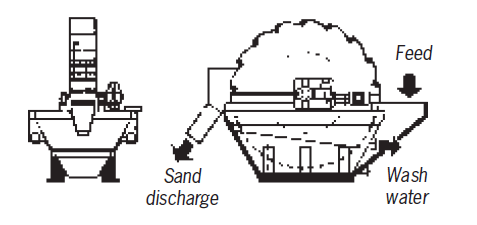
Drum Vacuum Filters
Vacuum filtration is the simplest form of “through blow” dewatering. A pressure differential created by a vacuum applied to the inside of the filter drum causes air to flow through the filter cake thereby displacing the contained water. The solids are retained on a filter cloth and are carried to discharge point by the rotation of the drum
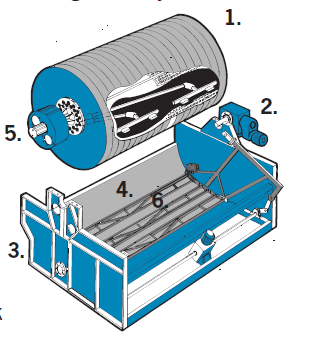
1. Drum,2. Drum drive,3. Support frame,4. ank,5. Vacuum head,6. Agitator
Belt Drum Filter
The belt discharge drum filter is similar to the standard drum version except that the cloth is separated from the drum and allowed to pass over a discharge system. This design allows cloth washing and is preferred for dewatering of slurries containing fine particles which produce a filter cake that is sticky and difficult to discharge. Three cake discharge options are
available.
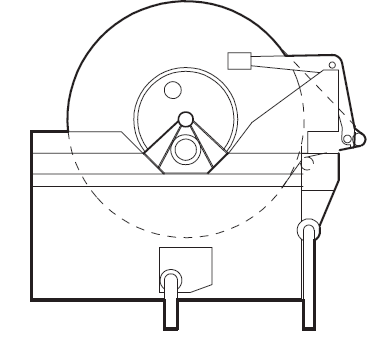
Vacuum Filters – Vacuum Requirement
By evacuating the air inside the filters dewatering can be achieved by air “through-blow”.Vacuum requirement is calculated as the volume of thinned air per effective filter surface area per minute. Thinned air volume is volume at actual reduced pressure.
Free air volume (used for sizing of compressors) is the volume at normal atmospheric pressure.
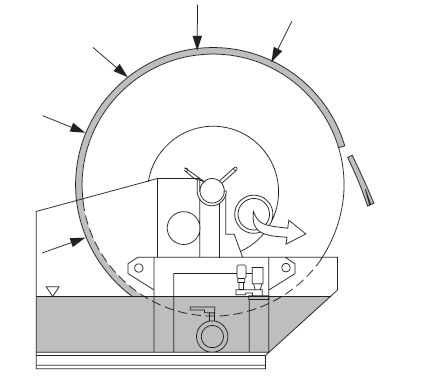
Vacuum requirements – Low vacuum applications (Dp 60 - 70 kPa, 8 - 10 psi)
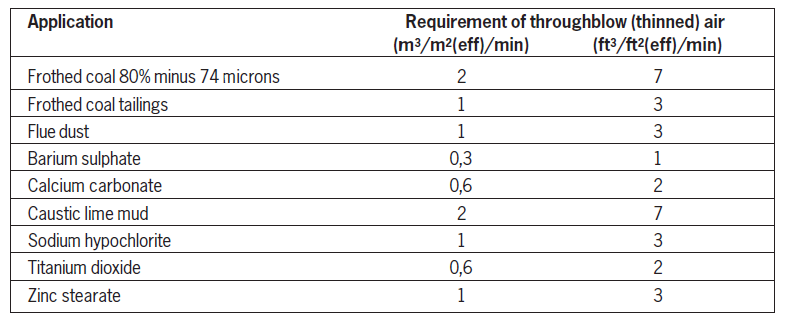
Vacuum requirement - High vacuum applications (Dp 80 - 90 kPa, 12 - 13 psi)
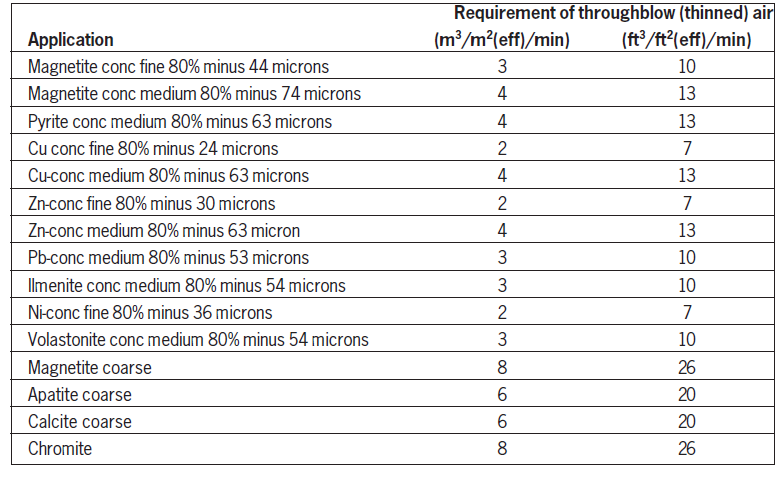
Vertical Plate Pressure Filter
The Pressure Filter is of “medium pressure” type operating in the pressure range of 6-10 bar. The machine mainly relies on the “air through blow” dewatering concept, whereby water is displaced by air as it passes through a filter cake.
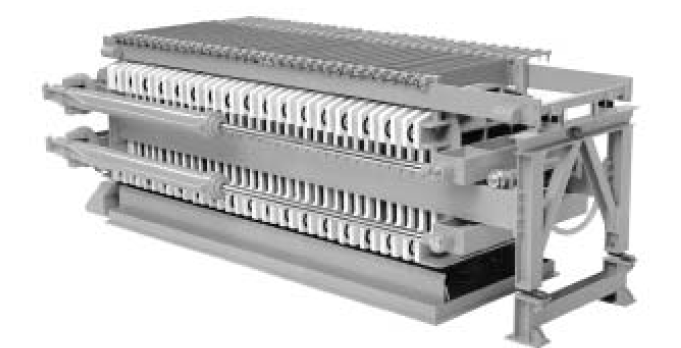
Pressure Filter - Product System
In a complete dewatering plant the compressed air filter is only one part of the system. The system consists of the following equipment:
Thickener to feed the filter with correct pulp density.
Buffer tank for deaeration and pulp density control prior to pump feeding.
Slurry pump for feeding during the filtration cycle. (3)
Valves for pulp, water and air. (4)
Rinse water system for the filter cloths. (5)
Weighing system for optimization of the operational parameters of filtration, compressed air drying, etc.
Compressor for compressed air supply. (6)
Computer based control system for operation and control of the filtration process.
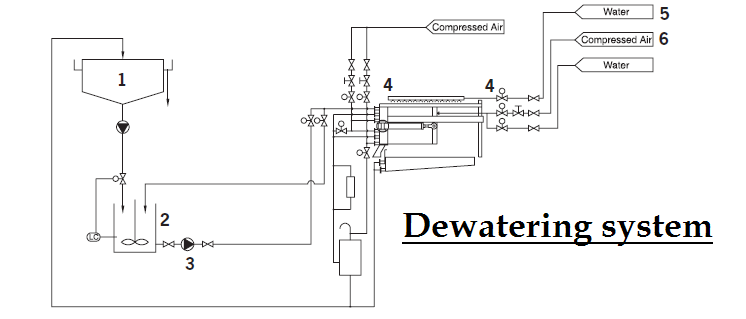
Thermal processing
If further upgrading is required we have to use thermal processing. Thermal processing is normally classified according to operating temperature.
Thermal low ( 100-200° C)
Used for drying - evaporating of liquids from solids – drying Type of equipment
• Direct Heat Rotary Dryers
• Indirect Heat Rotary Dryers
• Steam Tube Dryers
• Indirect Heat Screw Dryers (Holo-FliteR)
• Fluid Bed Dryers
Thermal medium (850 -950°C)
Used for calcining, clay swelling, limestone burning and foundry sand burn out
Type of equipment
• Direct Heat Rotary kilns
• Indirect Heat Rotary kilns
• Vertical Kilns
• Fluid bed Kilns
Thermal high (1300-1400°C)
Used for pelletizing of iron ore concentrates and petroleum coke calcining
Type of equipment
• Direct heat rotary kiln
Thermal processing is expensive. This means that lowest input in calories/ton isthe key issue. With raising operating temperatures this issue is getting more and more critical.
Dryers are normally not insulated but the kilns are refractory lined to protect the mechanical parts from the high temperatures needed for processing. Also the systems for heat recovery are getting more and more advanced with higher energy input.
Thermal processing equipment is always supplied as an integrated system consisting
of:
• Mechanical Dryer or Kiln, see above
• Feed and product handling equipment
• Combustion system (burner, fans, fuel system, etc.)
• Offgas handling equipment
• Dust collection system (wet or dry)
• Cooling system (optional)
Direct Heat Rotary Dryer
• Work horse of the mineral industry
• Wide range of internal designs for effective drying from start to end
• Special seals for closely controlled atmosphere
• Effective combustion and low maintenance burners, safe and reliable
• Diameter <0,6-5 m (2-17 ft), length 5-30 m (7-100 ft). Feed rates from less than
1 ton to 500 tons per hour
• Applications in minerals, clay, sand,aggregates, heavy chemicals and fertilizers
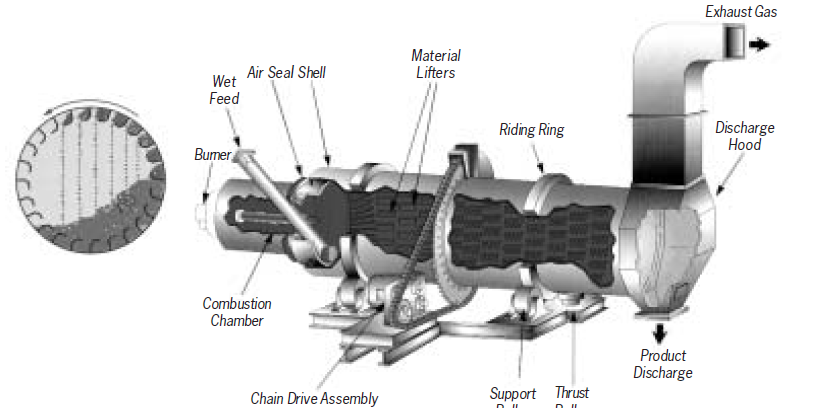
Indirect Heat Rotary Dryer (Kiln)
• Controlled environment interior excludes products of combustion
• Heat transfer by conduction and radiation
• Pulse-fired burners available
• Facilitates recovery of off-gases and product vapours
• Diameter 0,5m - 4,5 m (1.5-14 ft). Length 2.5 m to 30 m (8-96 ft).
• Applications in hazardous-, ultra fine- and combustible materials.
Regenera tion of active carbon, pyrolysis of waste rubber (car types)
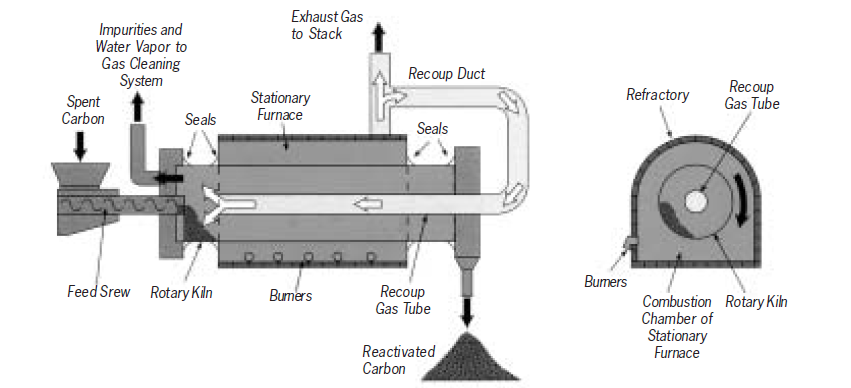
Steam Tube Dryer
• Indirect heating avoids product contamination
• Essentially automatic ( dryer adjusts to fluctuations in evaporation load).
• Low in maintenance, safe and reliable
• Steam pressure can range from 1,5 to 20 bar. Utilizes waste steam
• Capacities of 3 to 50 ton/hour, heating surfaces up to 2,250 m2 (24,000 ft).
• Diameter 1-4 m (3-14 ft), length 3-30 m (10-100 ft).
• Applications for heat sensitive materials, see also indirect drying above
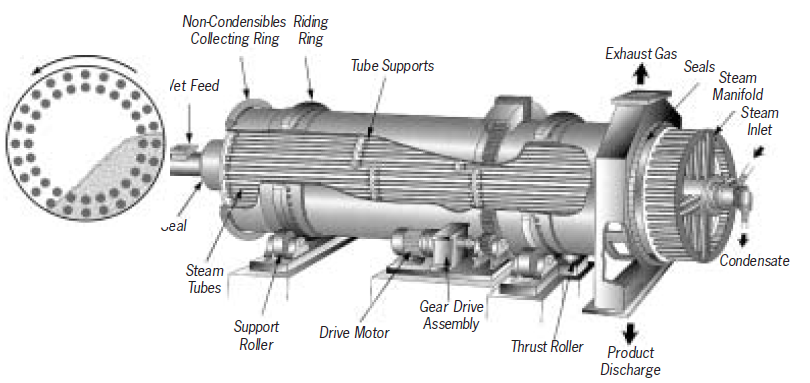
Something about cooling
In most thermal processing the temperatures of discharged products are high. In order to lower that temperature, or to recover some heat, or both, coolers are used.
Most of the coolers are inversely working dryers, however, with a higher capacity per installed unit.
Thermal Processing Systems
As said before all thermal processing installations are normally supplied as process system including the basic heating equipment with auxiliary system modules for combustion, offgas, dust collection, heat recovery, preheating cooling, feed and discharge, instrumentation and controls etc.
Iron Ore Pelletizing system (Grate – Kiln)
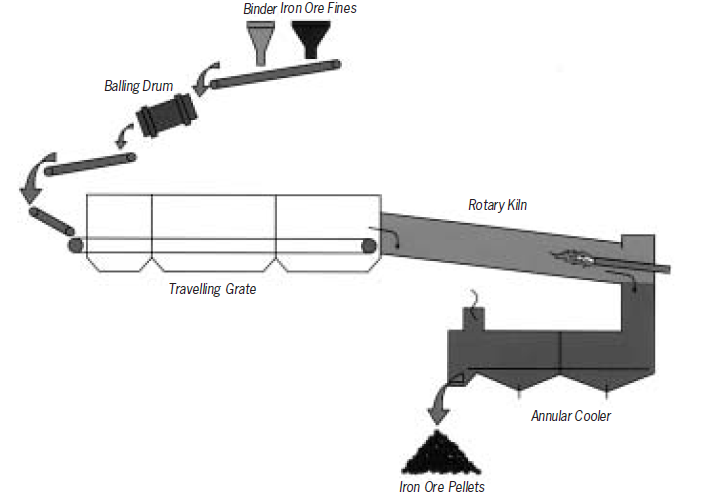
Lime Calcining System
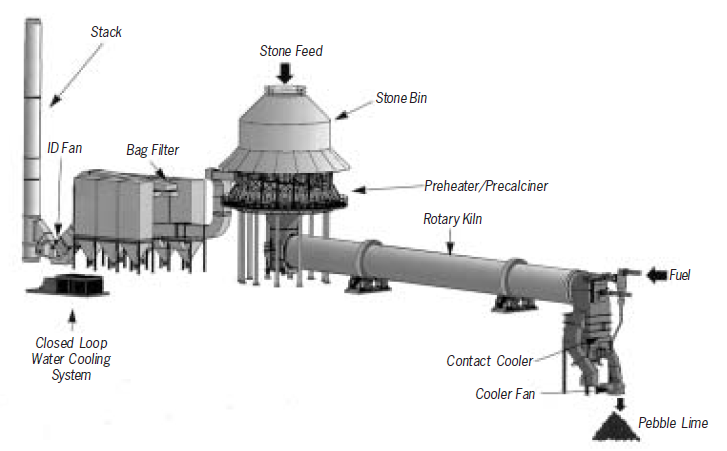
Coke Calcining System
